Chesham Hospital
Hospital Hill, Waterside, Chesham, Bucks HP5 1PJ
Medical
dates:
Medical
character:
Acute. Later, G.P.
A meeting was held on 31st October 1866 to discuss the establishment of a local hospital. Lord Chesham,
who presided at the meeting, donated a plot of land - Clever Piece
in the Town Field, some 5.7 acres - as a site for the hospital, and
fund-raising began in earnest.
The Chesham Cottage Hospital opened at the end of October 1869 with 7 beds and 1 cot. It had cost £866 to build, the money having been raised by subscriptions and donations. On 30th October 1869 the Lord Bishop of the Diocese, Bishop Wilberforce, held a service of dedication.
Lord Chesham became the President of the committee of management, donating £200 a year towards the running costs of the Hospital until his death in 1882.
The Hospital served the parishes of Chesham, Chesham Bois, Chenies, Latimer, Ashley Green and Chartridge. As a voluntary hospital, only subscribers or patients who had been recommended by a member of the committee were admitted. They stayed an average of 33 days, paying a minimum sum of 2 shillings and 6 pence (13p) a week towards their keep. Accident cases were admitted free at all times, but patients with a notifiable or infectious disease, chronic insanity or chronic disorder were excluded from admission.
In 1871 the town of Chesham suffered a severe epidemic of typhus. Among those who died were the 64-year-old surgeon Mr George Faithorn (one of the founders of the Hospital and its first Honorary Medical Officer), the Revd A.F. Aylward (Vicar of Chesham) and three nurses from London who were attending to the sick. Mr J.F. Churchill, also an Honorary Medical Officer, survived and eventually became Vice-President of the Hospital and Chairman of its managing committee.
The Hospital was enlarged in 1889 and the Accident Ward structurally altered.
At the beginning of the 20th century the drains were relaid and the Hospital site connected to the town's sewage system. A telephone system was also installed.
The Hospital was extended again in 1913. It then had 10 beds and a separate ward for private patients.
In 1915 the Ladies Linen League was founded. Its members supplied and repaired the Hospital's bed linen and the garments needed by in-patients.
In 1921 electricity was installed and, in the following year, a Department for Massage and Electrical Treatment was established.
In 1924, as a memorial to those of the Chesham area who had lost their lives during the Great War, the Hospital was greatly extended at a cost of £7,200. It then had 23 beds and became known briefly as the Chesham War Memorial Hospital. A portion of The Balks was purchased to protect the amenities of the Hospital.
In the mid 1920s, in-patients remained on average for 25 days. The weekly bed charges varied according to the age of the patient: adults paid 10 shillings (50p), while children aged between 7 to 14 years paid 7 shillings and 6 pence (38p), and those aged under 7 years 5 shillings (25p). A Workers Hospital Committee had been formed in 1923 and had established a contributory scheme whereby individuals could contribute 2d (1p) a week (3d - about 1p - for families), so that they would be exempted from maintenance and other Hospital charges if admitted.
In 1924 the average weekly cost of an in-patient was £3 4s 11d (£3.25).
In 1926 a portable X-ray apparatus was purchased. A Night Nurses' Home was built for £700 in 1927.
By 1928 the average weekly cost of an in-patient had increased to £4 6s 10d (£4.34) but, by 1930, when the Hospital had 22 beds, it had decreased to £4 0s 11d (£4.05).
In 1930 a water softener was installed and, in 1932, a wireless (radio) system in the wards.
By the mid 1930s the Hospital had 22 beds - 8 in the male ward, 7 in the female and 5 in the children's ward, and 2 private patient rooms. The number of beds occupied weekly was 16 - some 62-65% bed occupancy. Patients stayed on average for 21 days. In 1934 the average weekly cost of an in-patient was £4 4s 1d (£4.20). compared to £4 12s 2d (£4.61) in 1933. The minimum contribution expected from an adult was £1, for a child aged between 7 and 14 years 15 shillings (75p) and for a child under the age of 7 years 10 shillings (50p). (A half-week charge was made if the patient did not stay for over 4 days.) For an X-ray, the charge was 5 to 10 shillings (25 to 50p) for an in-patient and from 10s 6d to 21 shillings (53p to £1.05) for an out-patient (private patients paid between 1 to 3 guineas (£1.05 - £3.15). For dressings, the charge was 2 shillings (10p) a week and for a massage (physiotherapy) treatment 1s 6d (8p) per session (private patients paid 7s 6d (38p) or 10s 6d (53p) for electrical treatment and massage). The accounts were presented to the patient weekly.
Those involved in road traffic accidents received treatment free of charge but, although the Road and Rail Traffic Act, 1933, increased the amount recoverable from insurance, the Hospital management despaired of the financial liability that accident cases incurred.
The Hospital was greatly supported by the local population, who donated food and produce, especially eggs (some 6,000 were received in 1934!). The Chesham Horticultural Society sent garden produce at the end of its annual show. Items useful for the patients - magazines, books, etc. - were also given.
By 1935 the Massage Department had become too cramped. The Broadway Baptist Church offered the use of its School Hut to the Hospital, and the Department moved there with much relief. In the same year, a portable X-ray apparatus was donated by Mr Arthur E. Franklin.
In 1936 the weekly cost of an in-patient was £4 8s 2d (£4.41), compared to £4 13s 11d (£4.70) in 1935.
At the beginning of WW2 in 1939 the Hospital joined the Emergency Medical Service under the control of the Middlesex Hospital. A few beds were reserved for air-raid casualties but, in the event, were not needed and so became available again for the local population.
In 1948 the Hospital joined the NHS as a general hospital with 21 beds. It was under the control of the High Wycombe and District Group Hospital Management Committee, part of the Oxford Regional Health Board.
In 1974, following a major reorganisation of the NHS, the Hospital came under the authority of the High Wycombe District Health Authority, part of the Oxford Regional Health Authority. It became a General Practitioner-run hospital.
In 1982, after another major reorganisation of the NHS, it was under the control of the Wycombe District Health Authority.
In 1993, with the introduction of the 'marketplace' system' into the NHS, the Hospital joined the South Buckinghamshire NHS Trust. It had 21 beds for G.P.-referred patients (staffed by 5 nurses during the day and 3 at night), an Out-Patients Department with specialist clinics for ophthalmology, orthopaedics, gynaecology and paediatrics, facilities for blood tests, hearing tests, speech therapy, podiatry and mammography. District and Twilight (providing evening care) nurses were also based at the Hospital.
By the beginning of the 21st century, the Hospital was under the management of the Chiltern and South Bucks Primary Care Trust, and was under threat of closure.
The Trust regarded the buildings as unsuitable for modern nursing care - the floors sloped dangerously, there were no single rooms for dying patients, and there was not enough space for patients' bathrooms or for rehabilitation services. The main building was too small and had no reception area, there was no staff sitting room and the kitchen was cramped. The Out-Patients Department was small and unsuitable for disabled patients. At least £600,000 would be needed to upgrade the buildings to a suitable standard. Apart from that, access to the Hospital, at the top of a steep hill, was difficult for elderly patients, especially as no buses ran along that route. The unadopted road was dangerous in winter.
The Trust Chairman declared that the Hospital cost about £1m a year to run, that is, about £100,000 per person.
Despite a vigorous public campaign to save it, including a petition of almost 3,000 signatures, the remaining patients were transferred to the vacant Misbourne Ward at Amersham Hospital in 2004 and the Hospital closed in 2005.
The Chesham Cottage Hospital opened at the end of October 1869 with 7 beds and 1 cot. It had cost £866 to build, the money having been raised by subscriptions and donations. On 30th October 1869 the Lord Bishop of the Diocese, Bishop Wilberforce, held a service of dedication.
Lord Chesham became the President of the committee of management, donating £200 a year towards the running costs of the Hospital until his death in 1882.
The Hospital served the parishes of Chesham, Chesham Bois, Chenies, Latimer, Ashley Green and Chartridge. As a voluntary hospital, only subscribers or patients who had been recommended by a member of the committee were admitted. They stayed an average of 33 days, paying a minimum sum of 2 shillings and 6 pence (13p) a week towards their keep. Accident cases were admitted free at all times, but patients with a notifiable or infectious disease, chronic insanity or chronic disorder were excluded from admission.
In 1871 the town of Chesham suffered a severe epidemic of typhus. Among those who died were the 64-year-old surgeon Mr George Faithorn (one of the founders of the Hospital and its first Honorary Medical Officer), the Revd A.F. Aylward (Vicar of Chesham) and three nurses from London who were attending to the sick. Mr J.F. Churchill, also an Honorary Medical Officer, survived and eventually became Vice-President of the Hospital and Chairman of its managing committee.
The Hospital was enlarged in 1889 and the Accident Ward structurally altered.
At the beginning of the 20th century the drains were relaid and the Hospital site connected to the town's sewage system. A telephone system was also installed.
The Hospital was extended again in 1913. It then had 10 beds and a separate ward for private patients.
In 1915 the Ladies Linen League was founded. Its members supplied and repaired the Hospital's bed linen and the garments needed by in-patients.
In 1921 electricity was installed and, in the following year, a Department for Massage and Electrical Treatment was established.
In 1924, as a memorial to those of the Chesham area who had lost their lives during the Great War, the Hospital was greatly extended at a cost of £7,200. It then had 23 beds and became known briefly as the Chesham War Memorial Hospital. A portion of The Balks was purchased to protect the amenities of the Hospital.
In the mid 1920s, in-patients remained on average for 25 days. The weekly bed charges varied according to the age of the patient: adults paid 10 shillings (50p), while children aged between 7 to 14 years paid 7 shillings and 6 pence (38p), and those aged under 7 years 5 shillings (25p). A Workers Hospital Committee had been formed in 1923 and had established a contributory scheme whereby individuals could contribute 2d (1p) a week (3d - about 1p - for families), so that they would be exempted from maintenance and other Hospital charges if admitted.
In 1924 the average weekly cost of an in-patient was £3 4s 11d (£3.25).
In 1926 a portable X-ray apparatus was purchased. A Night Nurses' Home was built for £700 in 1927.
By 1928 the average weekly cost of an in-patient had increased to £4 6s 10d (£4.34) but, by 1930, when the Hospital had 22 beds, it had decreased to £4 0s 11d (£4.05).
In 1930 a water softener was installed and, in 1932, a wireless (radio) system in the wards.
By the mid 1930s the Hospital had 22 beds - 8 in the male ward, 7 in the female and 5 in the children's ward, and 2 private patient rooms. The number of beds occupied weekly was 16 - some 62-65% bed occupancy. Patients stayed on average for 21 days. In 1934 the average weekly cost of an in-patient was £4 4s 1d (£4.20). compared to £4 12s 2d (£4.61) in 1933. The minimum contribution expected from an adult was £1, for a child aged between 7 and 14 years 15 shillings (75p) and for a child under the age of 7 years 10 shillings (50p). (A half-week charge was made if the patient did not stay for over 4 days.) For an X-ray, the charge was 5 to 10 shillings (25 to 50p) for an in-patient and from 10s 6d to 21 shillings (53p to £1.05) for an out-patient (private patients paid between 1 to 3 guineas (£1.05 - £3.15). For dressings, the charge was 2 shillings (10p) a week and for a massage (physiotherapy) treatment 1s 6d (8p) per session (private patients paid 7s 6d (38p) or 10s 6d (53p) for electrical treatment and massage). The accounts were presented to the patient weekly.
Those involved in road traffic accidents received treatment free of charge but, although the Road and Rail Traffic Act, 1933, increased the amount recoverable from insurance, the Hospital management despaired of the financial liability that accident cases incurred.
The Hospital was greatly supported by the local population, who donated food and produce, especially eggs (some 6,000 were received in 1934!). The Chesham Horticultural Society sent garden produce at the end of its annual show. Items useful for the patients - magazines, books, etc. - were also given.
By 1935 the Massage Department had become too cramped. The Broadway Baptist Church offered the use of its School Hut to the Hospital, and the Department moved there with much relief. In the same year, a portable X-ray apparatus was donated by Mr Arthur E. Franklin.
In 1936 the weekly cost of an in-patient was £4 8s 2d (£4.41), compared to £4 13s 11d (£4.70) in 1935.
At the beginning of WW2 in 1939 the Hospital joined the Emergency Medical Service under the control of the Middlesex Hospital. A few beds were reserved for air-raid casualties but, in the event, were not needed and so became available again for the local population.
In 1948 the Hospital joined the NHS as a general hospital with 21 beds. It was under the control of the High Wycombe and District Group Hospital Management Committee, part of the Oxford Regional Health Board.
In 1974, following a major reorganisation of the NHS, the Hospital came under the authority of the High Wycombe District Health Authority, part of the Oxford Regional Health Authority. It became a General Practitioner-run hospital.
In 1982, after another major reorganisation of the NHS, it was under the control of the Wycombe District Health Authority.
In 1993, with the introduction of the 'marketplace' system' into the NHS, the Hospital joined the South Buckinghamshire NHS Trust. It had 21 beds for G.P.-referred patients (staffed by 5 nurses during the day and 3 at night), an Out-Patients Department with specialist clinics for ophthalmology, orthopaedics, gynaecology and paediatrics, facilities for blood tests, hearing tests, speech therapy, podiatry and mammography. District and Twilight (providing evening care) nurses were also based at the Hospital.
By the beginning of the 21st century, the Hospital was under the management of the Chiltern and South Bucks Primary Care Trust, and was under threat of closure.
The Trust regarded the buildings as unsuitable for modern nursing care - the floors sloped dangerously, there were no single rooms for dying patients, and there was not enough space for patients' bathrooms or for rehabilitation services. The main building was too small and had no reception area, there was no staff sitting room and the kitchen was cramped. The Out-Patients Department was small and unsuitable for disabled patients. At least £600,000 would be needed to upgrade the buildings to a suitable standard. Apart from that, access to the Hospital, at the top of a steep hill, was difficult for elderly patients, especially as no buses ran along that route. The unadopted road was dangerous in winter.
The Trust Chairman declared that the Hospital cost about £1m a year to run, that is, about £100,000 per person.
Despite a vigorous public campaign to save it, including a petition of almost 3,000 signatures, the remaining patients were transferred to the vacant Misbourne Ward at Amersham Hospital in 2004 and the Hospital closed in 2005.
Present status (October 2008)
The vacant building became derelict and was vandalised.
Update: March 2015
In September 2010 a fire, suspected as arson, destroyed much of the main building.
The site was sold for £1.8m to Chesham Care Ltd, who plan to demolish the old Hospital and replace it with a 5-storey nursing and rehabilitation centre, to have 80 beds.
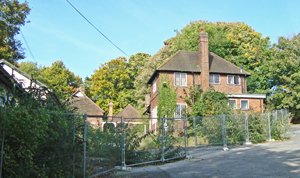
The main building from the east (above and below). The site is protected by wire mesh fencing.
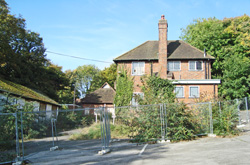
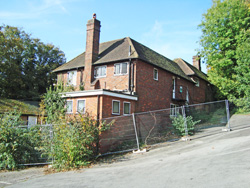
The steepness of the slope is noticeable!
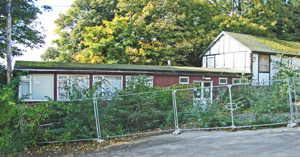
The southern extensions (above and below).
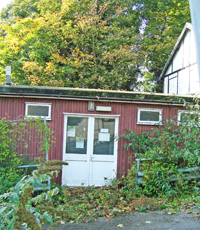
NB: Photographs obtained in March 2012
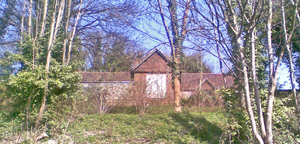
The former Hospital awaits demolition (above and below).
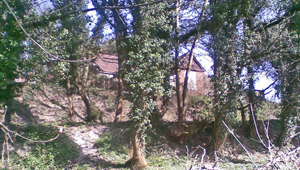
Hunt J 1977 Chesham. A Pictorial History. Chichester, Phillimore.
http://forebears.io
http://forever-changes.com
https://democracy.buckscc.gov.uk
www.28dayslater.co.uk
www.bbc.co.uk
www.buckinghamshireexaminer.co.uk
www.bucksfreepress.co.uk (1)
www.bucksfreepress.co.uk (2)
www.cheshammuseum.org.uk
www.flickr.com
www.flickriver.com
www.getbucks.co.uk
Return to home page